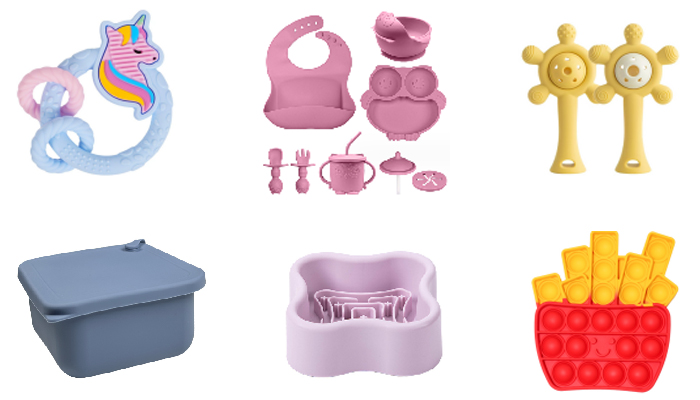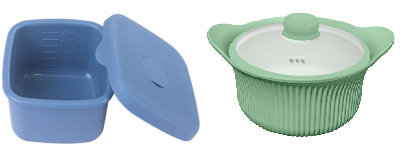

Professional Custom Silicone Products Manufacturer
At Ubetter Plastic, we specialize in manufacturing durable, complex, and cost-effective custom silicone products for the baby products, pet products, toys, daily necessities, medical, and consumer goods. Partner with us for exceptional quality from design to delivery.

What Is Silicone Compression Molding?
Silicone compression molding is a versatile and efficient manufacturing process for producing high-performance, soft silicone components. It is renowned for creating parts with superior material properties, excellent environmental resistance, and tight tolerances.
The Compression Molding Process for Silicone Rubber
The silicone compression molding process is a time-tested method that delivers exceptional value and part quality. It begins with a pre-weighed and pre-formed charge of uncured silicone material. This charge is placed directly into a heated mold cavity. The mold is then closed, and high pressure is applied, forcing the material to liquefy and flow uniformly throughout the entire cavity. Under controlled heat and pressure, the material undergoes vulcanization, cross-linking the polymer chains to form a durable, elastic solid. After the precise cure time is complete, the mold opens, and the finished silicone rubber part is removed, ready for any necessary post-processing.

Benefits of Choosing Silicone Compression Molding
1. Cost-Effectiveness for Medium to High Volumes
The compression molding process typically involves lower initial tooling cost compared to other methods like Injection Molding. This makes it an exceptionally economical choice for medium to high-volume production runs, delivering significant per-part savings without compromising on quality.
2. Superior Material Strength and Durability
Parts produced through compression molding exhibit excellent physical properties, including high tensile strength, tear resistance, and elongation. The process minimizes material degradation, resulting in robust and long-lasting silicone rubber parts.
3. Ability to Mold Complex Shapes and Thick Walls
This process is exceptionally capable of handling parts with intricate geometries and substantial cross-sections. It is the preferred method for manufacturing large silicone parts and components with thick walls that would be challenging for other techniques.
4. Excellent Sealing Properties and Environmental Resistance
From extreme temperatures to harsh chemicals and UV exposure, compression molded silicone parts provide reliable seals and gaskets. The inherent material properties of silicone, combined with this process, ensure outstanding performance in the most demanding environments.
Applications for Compression Molded Silicone Parts
We have over ten years of experience in mold making and manufacturing silicone products. Industry applications include baby silicone products, pet silicone products, toys, and daily necessities.


Baby Silicone Products Pet Silicone Products


Silicone Daily Necessities Silicone Toys
Our Silicone Compression Molding Expertise
Advanced Compression Molding Equipment
Our facility is equipped with a battery of modern compression molding presses ranging in tonnage to handle projects of all sizes. Our large platen size allows us to produce multiple parts per cycle or exceptionally large silicone parts, optimizing production efficiency.
In-House Mold Design and Fabrication
Our in-house mold making expertise is a cornerstone of our service. By controlling the entire mold tooling process, we guarantee precision, reduce lead times, and work closely with you to design for manufacturability (DFM), ensuring your part is optimized for the compression molding process.
Strict Quality Control and Consistency
Every batch of silicone material is rigorously inspected, and every step of our manufacturing process is monitored. We implement statistical process control (SPC) and conduct 100% final inspection to guarantee that every silicone rubber part we ship meets your exact specifications.
Wide Range of Silicone Materials and Compounds
We have extensive experience working with a vast portfolio of silicone compounds, including FDA-approved, medical-grade (USP Class VI), high-consistency rubber (HCR), and flame-retardant materials. We will help you select the perfect material for your application.

Our End-to-End Compression Molding Process
1. Design and Engineering Consultation
We start by collaborating with your team. Our engineers provide expert design for manufacturability (DFM) feedback to optimize your part for the compression molding process, ensuring quality, performance, and cost-efficiency.
2. Precision Mold Tooling Development
Our skilled toolmakers use high-grade steels and advanced machining to create durable, high-precision mold tooling. This critical step lays the foundation for part accuracy and long production run consistency.
3. Material Preparation and Pre-forming
The selected silicone material is carefully weighed and pre-formed into charges that match the specific volume required for the part, ensuring consistency and minimizing waste during the molding and curing process.
4. The Molding and Curing Process
The pre-form is placed into the heated mold. Our automated presses apply precise temperature and pressure for the exact cure time required to achieve full vulcanization, resulting in a stable and durable part.
5. De-flashing and Post-Processing
After molding, parts undergo deflashing to remove any excess material (flash). We also offer a full range of post-processing services, including bonding, adhesion, printing, and assembly to deliver a ready-to-install component.
6. Final Inspection and Packaging
Every custom silicone part undergoes a final quality check against your drawing. Once approved, parts are meticulously packaged to prevent damage during shipping and delivered to you on time.
FAQs About Silicone Compression Molding
Q1: What is the difference between compression molding and injection molding for silicone?
While both are effective, compression molding is often chosen for larger parts, thicker cross-sections, and when lower tooling cost is a priority. Injection molding typically allows for faster cycle times and more intricate, smaller parts but with higher initial tooling investment. The best method depends on your part's geometry, volume, and budget.
Q2: What are the typical lead times for compression molding tools and parts?
Lead times for compression molding tools can vary from 3-6 weeks, depending on complexity. Once tools are approved, production part lead times are typically 2-4 weeks. We prioritize rapid turnaround and will provide a precise timeline for your project.
Q3: What types of silicone materials are suitable for the compression molding process?
A wide variety of silicone materials are suitable, including standard HCR (High-Consistency Rubber), medical-grade, food-grade, and high-temperature compounds. We will help you select the right silicone compound based on your requirements for hardness, tensile strength, temperature resistance, and regulatory compliance.
Q4: How do you ensure the consistency and quality of molded silicone parts?
We ensure consistency through rigorous quality control at every stage. This includes raw material inspection, controlled manufacturing process parameters (time, temperature, pressure), and 100% final part inspection. Our in-house mold making also allows us to maintain tight control over the most critical element—the tooling.
Ready to Start Your Silicone Products Project?
You've seen our process, our capabilities, and our commitment to quality. Now, let's discuss how we can bring your project to life with high-performance, reliable custom silicone parts.
Contact us today for a free quotation and design-for-manufacturability analysis. Our silicone molding experts are ready to assist you.
We chat
